You are using an out of date browser. It may not display this or other websites correctly.
You should upgrade or use an alternative browser.
You should upgrade or use an alternative browser.
A 'gentle' rebuild of my 3500
- Thread starter Mikep
- Start date
As Stina says, that is the number for the SD1 castings, see here:
http://www.v8forum.co.uk/forum/viewtopic.php?t=133
http://www.v8forum.co.uk/forum/viewtopic.php?t=133
Mikep
Active Member
stina said:ERC 0216 is the number for SD1 heads , Do yours have single or double valve springs ?
I believe I have single valve springs. I suspected that they weren't SD1 heads. It seems odd to fit an SD1 block and not the heads as well but that would appear to be the case here.
At least I can make sure I fit the right needles to my carbs.
Edit:
Having done a bit of checking on the internet it seems they are P6 heads and my block is from an SD1 auto, 9.35cr 1976 - 1987.
I wonder what the advantages/ disadvantages are in having P6 heads on a lower compression block?
stina
New Member
Single valve springs are SD1 Mike , Double springs equal P5/P6 heads . 
The advantage of early SD1 heads over P6 is larger valves , harder valve seats , better breathing . I know people will now say how much better 10 bolt heads and other alternatives are but if you have SD1 heads and you just want a nice usable road engine then you have a good starting point i guess
Ps long reach plugs in SD1 heads , short reach in P6
The advantage of early SD1 heads over P6 is larger valves , harder valve seats , better breathing . I know people will now say how much better 10 bolt heads and other alternatives are but if you have SD1 heads and you just want a nice usable road engine then you have a good starting point i guess
Ps long reach plugs in SD1 heads , short reach in P6
Mikep
Active Member
stina said:Single valve springs are SD1 Mike , Double springs equal P5/P6 heads .
The advantage of early SD1 heads over P6 is larger valves , harder valve seats , better breathing . I know people will now say how much better 10 bolt heads and other alternatives are but if you have SD1 heads and you just want a nice usable road engine then you have a good starting point i guess
Ps long reach plugs in SD1 heads , short reach in P6
Arrrggghh, now I'm confused
I guessed the number of valve springs
stina
New Member
Ah ,now i see where your coming from , as in most situations you would end up with a p6 short motor and SD1 heads , you seem to have ended up with SD1 block and P6 heads , Who knows what someone did in the past to keep it rolling  Seemed to pull away pretty well when i was following you towards that show few months back
Seemed to pull away pretty well when i was following you towards that show few months back 
Another way to tell what heads it has is assuming it has the correct plugs they should be short reach for P6 , long for SD1 .
Having said that i was helping a mate yesterday with an old "project" and it had 5xshort & 3xlong reach plugs :shock: Didn't run too well
"project" and it had 5xshort & 3xlong reach plugs :shock: Didn't run too well 
Another way to tell what heads it has is assuming it has the correct plugs they should be short reach for P6 , long for SD1 .
Having said that i was helping a mate yesterday with an old
Hi Mike,
The thread length on the spark plug will confirm the type of head, no need to remove the rocker, unless you wish to know whether it has single or double valve springs. The early heads can have their double valve springs replaced with single valve springs.
Ron.
The thread length on the spark plug will confirm the type of head, no need to remove the rocker, unless you wish to know whether it has single or double valve springs. The early heads can have their double valve springs replaced with single valve springs.
Ron.
stina
New Member
SydneyRoverP6B said:Hi Mike,
The thread length on the spark plug will confirm the type of head, no need to remove the rocker, unless you wish to know whether it has single or double valve springs. The early heads can have their double valve springs replaced with single valve springs.
Ron.
If i wanted to be pedantic Ron the thread length of the plugs will only confirm the length of the plugs fitted ! Admitted if all is as it should be and it has the correct plugs for the correct head then you could rely on that to confirm the heads . To be sure measure the actual depth of the female plug thread in the heads
That is true Stina. I was relying on the concept that the person who had fitted them would be competent, and as I was thinking of Mike when I wrote it, an alternative didn't cross my mind.
A person could fit short thread plugs into an SD1 head, but the engine won't be running all that well. Going the other way is a non starter as the long reach plugs will hit the top of the pistons :shock:
Ron.
A person could fit short thread plugs into an SD1 head, but the engine won't be running all that well. Going the other way is a non starter as the long reach plugs will hit the top of the pistons :shock:
Ron.
Mikep
Active Member
Other than confusing myself as the type of cylinder heads fitted to my car I continued with cleaning up the inlet manifold and fitting the new gaskets.
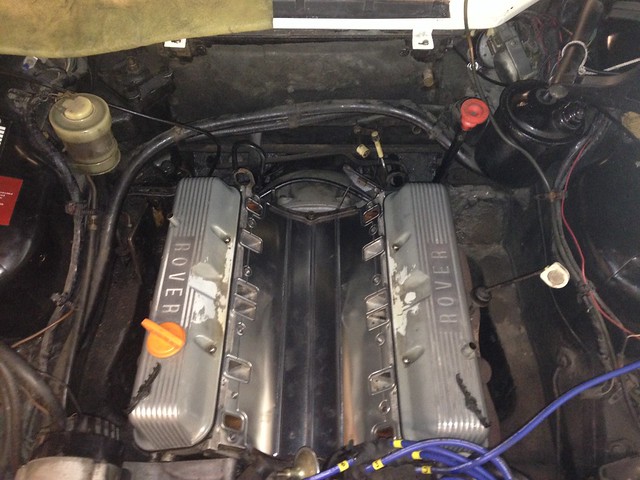
The peeling grey paint is quite obvious in this photo.
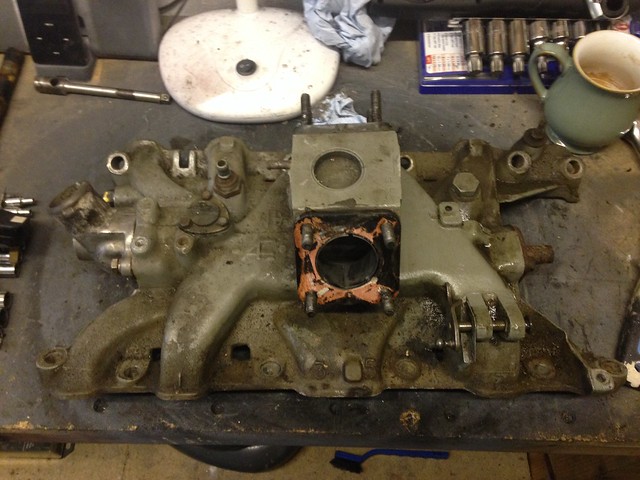
Before a liberal dose of elbow grease.
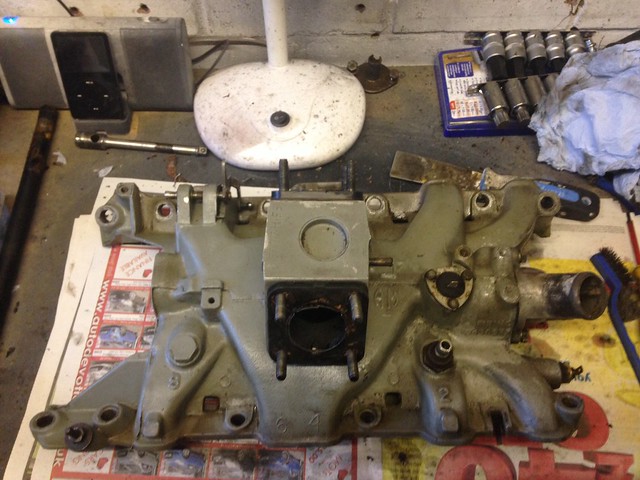
It's amazing what a toothbrush and some paraffin can do.
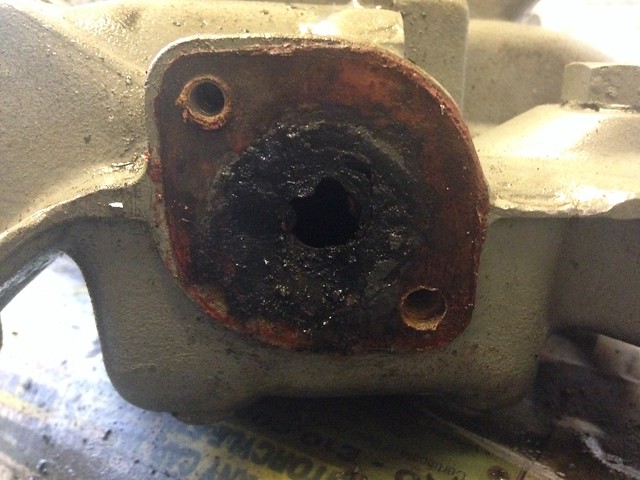
This is what confronted me when I removed the rear pipe outlet.

It turned out to be accumulated crud and tbh the hole in the crud equated to the pipe diameter but all the same it was best to clear this out.

Certainly looking cleaner. I have temporarily place the manifold in place just to keep it out if the way. I wish I had a bigger garage.
Now its time to move onto the carbs themselves

The peeling grey paint is quite obvious in this photo.

Before a liberal dose of elbow grease.

It's amazing what a toothbrush and some paraffin can do.

This is what confronted me when I removed the rear pipe outlet.

It turned out to be accumulated crud and tbh the hole in the crud equated to the pipe diameter but all the same it was best to clear this out.

Certainly looking cleaner. I have temporarily place the manifold in place just to keep it out if the way. I wish I had a bigger garage.
Now its time to move onto the carbs themselves
Hi Paul,
The 3.5 litre engines manufactured from 1980 through to 1993 were known as "stiff blocks". They were cast differently being strengthened in a number of places. The most obvious being the ribs that run across the lifter gallery, these were considerably larger in cross sectional area, hence the name the blocks received.
The P6B heads have threads for the plugs some 12mm in depth, all others are 19mm. In both cases, the electrode will just protrude into the combustion chamber.
Ron.
The 3.5 litre engines manufactured from 1980 through to 1993 were known as "stiff blocks". They were cast differently being strengthened in a number of places. The most obvious being the ribs that run across the lifter gallery, these were considerably larger in cross sectional area, hence the name the blocks received.
The P6B heads have threads for the plugs some 12mm in depth, all others are 19mm. In both cases, the electrode will just protrude into the combustion chamber.
Ron.
testrider
Active Member
SydneyRoverP6B said:The P6B heads have threads for the plugs some 12mm in depth, all others are 19mm. In both cases, the electrode will just protrude into the combustion chamber.
So if Mike measures the depth of the spark plug hole on his engine with a bit of wire that will identify which 'heads they are.
Mikep
Active Member
testrider said:SydneyRoverP6B said:The P6B heads have threads for the plugs some 12mm in depth, all others are 19mm. In both cases, the electrode will just protrude into the combustion chamber.
So if Mike measures the depth of the spark plug hole on his engine with a bit of wire that will identify which 'heads they are.
This is something I will try later to 100% confirm.
Mikep
Active Member
It's turns out I definitely have P6 heads as my Dad actually measured the bores a couple of years ago before he bought new plugs. That's that sorted.
Today I have totally stripped both carbs back to their component pieces and I think a full rebuild kit is in order as all the seals need replacing as well as the spindles and butterflies plus I'll b changing the needles.
One thing I'm not sure about are the cold start enrichment devices. There appears to be what I initially thought was an 'O' ring on one part of the assembly but it seems to be integral or maybe stuck. It is a little chewed up in places on both of them. For those that know do these look serviceable? I'm assuming they act as a seal. I don't want to replace them if I have to as they are about £18 each :shock:
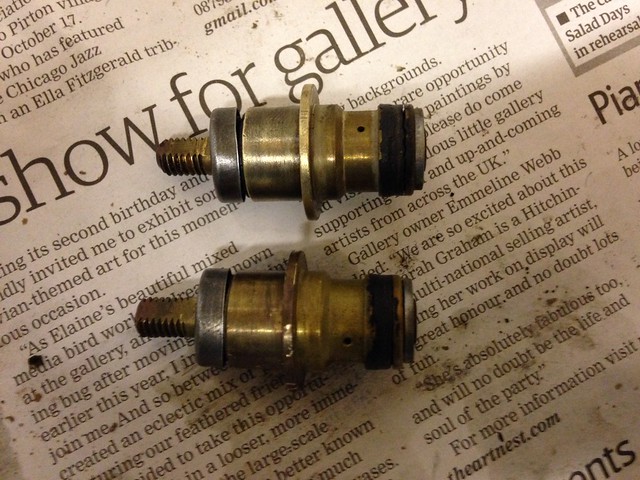
The bit in question is the black ring on the right hand side. You can see they are a little worn.
Today I have totally stripped both carbs back to their component pieces and I think a full rebuild kit is in order as all the seals need replacing as well as the spindles and butterflies plus I'll b changing the needles.
One thing I'm not sure about are the cold start enrichment devices. There appears to be what I initially thought was an 'O' ring on one part of the assembly but it seems to be integral or maybe stuck. It is a little chewed up in places on both of them. For those that know do these look serviceable? I'm assuming they act as a seal. I don't want to replace them if I have to as they are about £18 each :shock:

The bit in question is the black ring on the right hand side. You can see they are a little worn.
Hi Mike,
It is an 'O' ring on the end of each cold start valve, and ideally you should replace them. I am pretty sure that my replacement 'O' rings came with the kits that I purchased. You could always go to a bearing supplier of similar and have them match the 'O' rings. Fuel resistant nitrile is what you're after.
On the subject of needles, what did you have in mind? There seems to be a propensity to fit excessively rich needles into engines there in the U.K. If the fuel contains ethanol, then that would be a reasonable explanation, if not then apart from engine damage through bore wash, power will also be lost.
The original BBG or BBV needles within the HIF6 carburettors are almost perfect when delivering the correct air/fuel ratio at the top end. I know this from having an air/fuel ratio printout of my Rover's original engine, which I'll put up shortly within the thread I started within the engine section. If you fit better flowing air filters, then the needles will need changing, but the difference will be minimal.
Ron.
It is an 'O' ring on the end of each cold start valve, and ideally you should replace them. I am pretty sure that my replacement 'O' rings came with the kits that I purchased. You could always go to a bearing supplier of similar and have them match the 'O' rings. Fuel resistant nitrile is what you're after.
On the subject of needles, what did you have in mind? There seems to be a propensity to fit excessively rich needles into engines there in the U.K. If the fuel contains ethanol, then that would be a reasonable explanation, if not then apart from engine damage through bore wash, power will also be lost.
The original BBG or BBV needles within the HIF6 carburettors are almost perfect when delivering the correct air/fuel ratio at the top end. I know this from having an air/fuel ratio printout of my Rover's original engine, which I'll put up shortly within the thread I started within the engine section. If you fit better flowing air filters, then the needles will need changing, but the difference will be minimal.
Ron.
Mikep
Active Member
SydneyRoverP6B said:It is an 'O' ring on the end of each cold start valve, and ideally you should replace them. I am pretty sure that my replacement 'O' rings came with the kits that I purchased. You could always go to a bearing supplier of similar and have them match the 'O' rings. Fuel resistant nitrile is what you're after.
I thought as much Ron. I'l wait till I get my rebuild kit before I remove them but the more I look at them the more I can see they have been squashed and are stuck fast
SydneyRoverP6B said:On the subject of needles, what did you have in mind? There seems to be a propensity to fit excessively rich needles into engines there in the U.K. If the fuel contains ethanol, then that would be a reasonable explanation, if not then apart from engine damage through bore wash, power will also be lost.
The original BBG or BBV needles within the HIF6 carburettors are almost perfect when delivering the correct air/fuel ratio at the top end. I know this from having an air/fuel ratio printout of my Rover's original engine, which I'll put up shortly within the thread I started within the engine section. If you fit better flowing air filters, then the needles will need changing, but the difference will be minimal.
Ron.
I'm going to try BCA needles to begin with as Richard Faulkner's Winsu program has suggested a few types, BCA,BAC,BBC,BDS. Out of those BCA looks smoother on the graph. I think Stina is fitting BAC needles on hers, but she does have SD1 heads. We are taking into consideration K&N style filters and my car has a full stainless exhaust system with straight through silencers. As far as ethanol content I believe its currently 5% here in the UK with it potentially increasing to 10%.
stina
New Member
Hi Mike .
When i did mine i found the rebuild kit contained everything , some parts even doubled up , I did everything apart from shafts and butterflies as they were o.k . When you get into it it's quite simple , I did have a borrowed set of assembled carbs though which made reassembly easier ( to copy spring positioning etc ) . Worth the effort though .
When i did mine i found the rebuild kit contained everything , some parts even doubled up , I did everything apart from shafts and butterflies as they were o.k . When you get into it it's quite simple , I did have a borrowed set of assembled carbs though which made reassembly easier ( to copy spring positioning etc ) . Worth the effort though .

